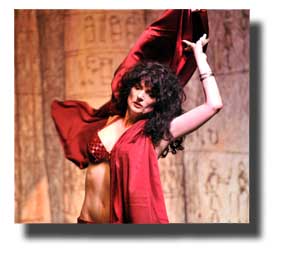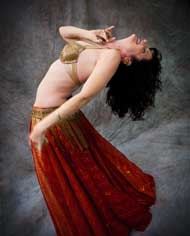Traditional Cabaret Style
Belly Dance
An Extremely Short History and Background
of Traditional Cabaret Style Belly Dance
Belly Dancing is the oldest form of dance on the planet, dating back thousands of years; although it has only been known in our country since the 19th century. The solo form, or Cabaret style (sometimes called American Cabaret Style), began in restaurants and nightclubs in the Middle East only within the last century, and only since the 1960's has it been a part of the United States' entertainment scene. A fledging film industry in Egypt sought to mimic the musical comedies produced in Hollywood at the time. Famous dancers such as Badiaa Masaabni, Samya Gamal, Tahiya Karioka, and Naima Akef appeared in many black and white movies and became an inspiration for dancers in Egypt and all over the world.
The Cabaret routine, performed by a solo dancer, consists of several short pieces of music of varying speed, instrumentation, and mood. The audience would be seated, eating and drinking during the performance, and most venues were intimate in nature; sometimes with a stage, and sometimes without. Traditionally, the dancer wears a flashy, two – piece costume called a bedlah over very full skirts, and she would always play zils, or finger cymbals (except during veil or while handling a prop.) Improvisational in nature, this "freestyle" dance form reflects the soloist's skill in interpreting the music through her movement and imparts a sense of immediacy to the audience, much as a jazz musician's "solo" would. The intimate nature of the venue allows for some interaction with the audience as well.
The usual dancer's solo begins with an opening, or greeting song, then moves on to a veil piece followed by another fast piece, or a drum solo. For longer programs, there will be music for a slow, standing movement piece called taxsim, or floor work (sometimes a dancer will use a prop for this portion) followed by a finale.
In the last 20 years, a movement toward ATS (American Tribal Style) and Modern Egyptian style belly dance has rendered Cabaret the label of "retro" or "old school" belly dance. Those of us who love this style, who perform it and teach it, who love playing zils and dancing to music that tells a story, prefer to call it "classic."
Private Lessons & Events

- Instruction for all levels of belly dancing.
- Private events, parties and conventions.
- Local venues that feature Annette's dancing..

